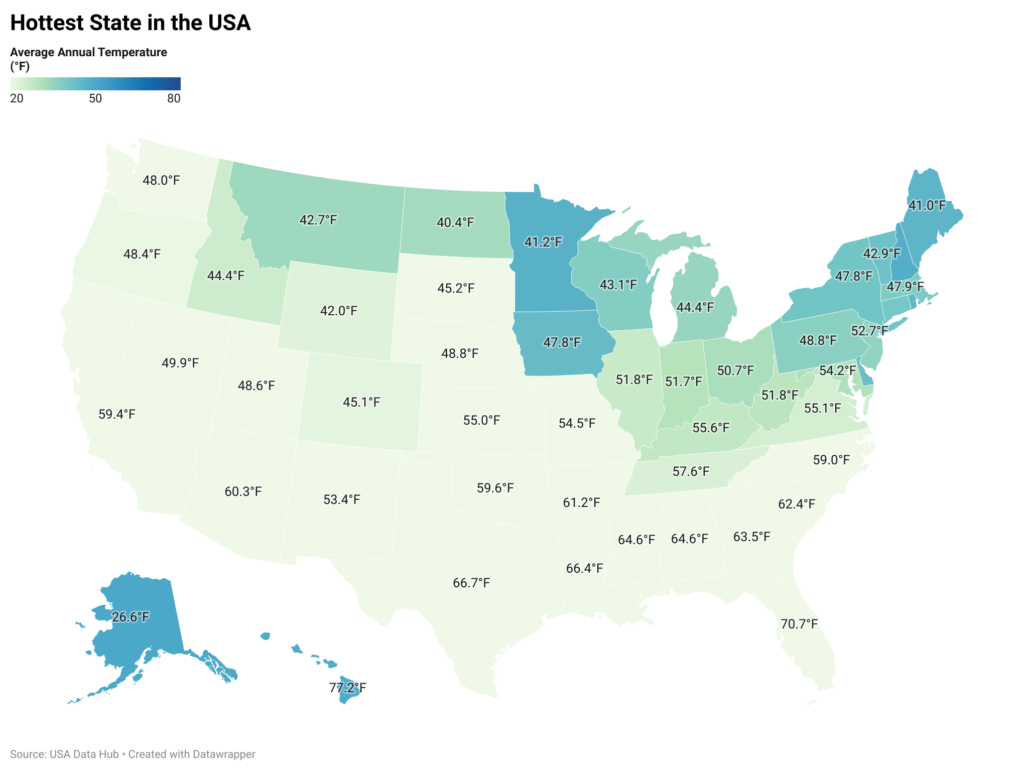Hottest State In USA - Where The Sun Shines Brightest
Ever wonder which spot in the United States truly feels the sun's full warmth, day in and day out? It's a common thought, especially when you're looking for a sunny escape or just curious about the nation's climate variations. We often talk about how big the USA is, and with that vastness comes a wide array of weather experiences, from chilly northern spots to places where the air always seems to carry a gentle warmth.
The country, in some respects, truly is a collection of many different weather patterns. You have areas that see snow for months and others where winter coats are practically unheard of. This big difference in how the weather behaves across the land is, you know, a direct result of the country's huge size and its very varied natural features. From coast to coast, the land changes, and so does the air temperature.
So, it's almost natural to ask: which specific part of this large land mass consistently experiences the highest temperatures? What makes one place feel considerably warmer than another? We're going to explore just that, looking at what makes some states stand out for their consistently elevated warmth throughout the year, and, you know, which ones are at the very top of that list.
Table of Contents
- What Makes a State Feel So Warm?
- Where Does the Thermometer Go Highest?
- Is Your State One of the Hottest States in USA?
- What About the Hottest State in USA's Landscape?
What Makes a State Feel So Warm?
When we talk about states that are consistently warm, it's not just about one thing; there are a few elements that really play a part. You see, the overall weather patterns, how much moisture is in the air, and the general conditions of the environment all contribute to how warm a place feels. For instance, some places might have very high temperatures, but if the air is dry, it feels different than a place with the same temperature but a lot of moisture. It's, like, a combination of things that create the feeling of heat.
The United States, being so large, has a truly varied collection of environmental conditions. From the very cold expanses of Alaska to the very warm wetlands of Florida, the range is quite broad. Most of the states that experience the highest temperatures are, as a matter of fact, situated in the southern parts of the country. This makes a lot of sense when you consider how the sun's rays hit the Earth more directly closer to the equator. So, you know, location plays a big part in it all.
The Climate Features of the Hottest State in USA
To really get a sense of which states are the warmest, we need to look at more than just the highest temperature recorded on a single day. We need to consider things like the average temperature over a whole year, the amount of moisture in the air, and the typical weather patterns that shape the seasons. For example, some states might have short periods of very intense heat, while others have a longer period of consistently high warmth. It's, you know, a bit like comparing a quick sprint to a long marathon when it comes to feeling the heat.
- Abigail Martin Net Worth
- Tom Selleck Politics
- Friends The Reunion
- Wyclef Jean Net Worth
- Goblin Cave Anime Wiki
States that frequently top the charts for warmth often share some common environmental characteristics. They might be close to large bodies of water that bring in warm, moist air, or they could be in areas where the land itself tends to hold onto heat. We’re talking about places where the air itself just feels warm for most of the year. This includes, for instance, states from Florida all the way to Arizona, each with their own particular reasons for feeling so warm, whether it’s a lot of moisture or very dry air. So, there's a lot to consider.
Understanding Factors Behind High Temperatures
When we talk about why certain places get so warm, there are some pretty clear factors at play. The angle of the sun, how close a place is to the equator, and the type of land it sits on all make a difference. Think about it: a flat area might warm up differently than a mountainous one. Also, the presence of large water bodies, like oceans, can bring in warm air and moisture, making the air feel even more intense. It’s, basically, a complex dance of natural elements.
For instance, places that have a lot of flat land or are near warm ocean currents tend to experience higher average temperatures. The sun's energy can spread out and warm these areas more evenly. Then there's the effect of air movement; warm air masses can settle over certain regions, keeping temperatures elevated for extended periods. It's really quite interesting to see how these elements combine to create a place that feels, you know, pretty warm for a long time.
Where Does the Thermometer Go Highest?
Many of us wonder which states truly have the highest average temperatures. It's not just about a single day's record; it's about the warmth that sticks around for most of the year. When we look at the numbers, it becomes clear that some places are just consistently warmer than others. This is based on measurements taken throughout the year, giving us a pretty good idea of where the warmth truly settles in. So, you know, let's see what the numbers tell us.
It's worth noting that every single state in the United States has, at some point, recorded a temperature of at least 100 degrees. Some have even seen temperatures well above 115 degrees. This tells us that intense summer warmth is not at all unfamiliar across the country. But, there's a big difference between a few days of extreme warmth and a state that feels quite warm for most of the year. We are looking at those places where the warmth is a regular feature, not just an occasional visitor, you know?
The Hottest State in USA - A Look at Recent Figures
Based on information from the National Oceanic and Atmospheric Administration, which collects a lot of weather data, we can get a good picture of which states were the warmest. For example, looking at data from 2023, Hawaii, Florida, and Texas were among the leading states for warmth. These figures consider the average temperatures across the entire state for the whole year. It gives us a very clear sense of where the warmth is most persistent, you know, throughout the calendar.
When we look at the numbers for 2024, again from NOAA data, ranked by the highest statewide average temperature from January to December, Florida often comes out on top. It's followed by states like Louisiana, Texas, and other places that are either quite moist or very dry. This data provides a solid basis for understanding which states consistently experience the highest average warmth, giving us a good idea of the hottest state in USA contenders. So, that's pretty much how they figure it out.
Specifically, Florida has shown itself to be a truly warm place, with an average temperature that is significantly higher than the overall average for the United States. For instance, Florida's average temperature can be around 71.5 degrees, or even 72.5 degrees Fahrenheit, making it noticeably warmer. To put that in perspective, it can be about 19 degrees warmer than the US's average temperature of roughly 53 degrees. That's a pretty big difference, honestly, when you think about it across a whole year.
Exploring Specific Locations of Intense Warmth
While we talk about states as a whole, it's also helpful to think about where within those states the warmth really concentrates. Some areas, like specific counties or cities, might experience even more intense conditions than the state average suggests. This is often due to local features, like being in a valley that traps heat or having a lot of concrete that holds onto warmth. It’s, in a way, like finding the warmest pockets within already warm places.
Take Arizona, for instance. It's very well known for its truly scorching temperatures, especially in cities like Phoenix and Tucson. These places experience consistently high temperatures, making Arizona a strong contender for the hottest state in USA. The air there just feels, you know, incredibly warm for a good portion of the year. This kind of local intensity contributes a lot to the state's overall reputation for warmth.
Is Your State One of the Hottest States in USA?
Many people are curious about where their own state stands on the warmth scale. It’s natural to wonder if you live in one of the places that experiences the most consistent warmth. The United States is truly vast, and it has a wide variety of environmental conditions. So, what state truly experiences the highest warmth? It's a question that brings up a lot of interesting information about how different parts of the country feel the sun's presence.
When we look at how states compare, we consider the state's mean annual temperature. This is basically the average of the twelve monthly average temperatures for each state. It gives us a fair way to compare places, showing which ones maintain higher warmth over the entire year, rather than just having a few very warm days. This method helps us understand the true year-round warmth of a place, you know, pretty accurately.
How States Compare in Terms of Average Warmth
Comparing states by their average annual warmth shows some clear patterns. Florida often ranks overall as the warmest state year-round. This means that its temperatures, on average, remain higher throughout all seasons compared to other places. It's not just about summer warmth; it's about the gentle warmth that persists even when other parts of the country are feeling quite cool. So, it's a pretty consistent warmth there.
Beyond Florida, other states like Louisiana and Texas also consistently appear near the top of the list for average warmth. Hawaii, too, with its tropical feel, is always among the warmest. These states share characteristics that contribute to their high average temperatures, whether it's their location, proximity to warm waters, or the general pattern of air movement. It’s, basically, a combination of things that keeps them feeling warm.
The variations in how warm different parts of the country are truly are a result of the country’s vast size and its very diverse natural features. You can go from very cold northern areas to places with tropical coastlines, and the country experiences a wide range of temperatures throughout the year. However, some states, like those we've talked about, truly stand out for their consistently elevated temperatures, earning them the reputation of being the warmest states in America, you know, for good reason.
What About the Hottest State in USA's Landscape?
The physical features of a state can play a very big part in how warm it gets. The kind of land, whether it’s flat, hilly, or desert, can influence how much heat the sun's rays can create and hold. For example, large, open, flat areas tend to warm up more evenly and can stay warm for longer periods. This is a pretty significant factor in understanding why some states feel so much warmer than others. It's, like, the land itself contributes to the warmth.
When you think about the states that are consistently warm, you often find that their natural surroundings are key. Areas with a lot of open land, or those near large bodies of water that bring in warm air, tend to feel the warmth more intensely. It's not just about the sun's strength; it's also about how the land absorbs and radiates that warmth back into the air. So, the ground beneath your feet has a role to play, you know?
Texas - A Case Study in Warmth
Texas is a really interesting example when we talk about warm states. It's a place full of different cultures, cities, and types of food, and it's also known for being very warm. Texas feels so warm largely because of its very flat land. This includes, most notably, the Gulf Coast in the southern part, which is near warm ocean waters. Then there's the Chihuahuan Desert to the west, which is naturally a very warm and dry area. And finally, the Great Plains spread throughout the state also contribute to its overall warmth. It's, you know, a mix of these elements.
The vast, open spaces of Texas allow the sun's warmth to spread across a huge area without much interruption from mountains or large bodies of cool water. This means that the warmth can build up and stay for extended periods, especially during the warmer months. The combination of these geographical features helps explain why Texas consistently ranks as one of the warmest states in the US. It's, pretty much, a natural oven in some respects.
So, when you look at a place like Texas, you can really see how the land itself contributes to the feeling of warmth. The flat areas, the desert, and the coastal influences all work together to create an environment where high temperatures are a common occurrence. It’s a good example of how the physical world shapes the weather we experience, making it a truly warm place to be. That, you know, pretty much sums up why it's so warm there.
This exploration has taken us through the factors that make certain states feel so warm, from the influence of their location and natural features to the specific data that shows us which states consistently top the charts for average temperatures. We've seen how places like Florida and Texas, with their unique environmental characteristics, stand out for their persistent warmth. It's clear that the United States, with its vastness, offers a wide range of climates, but some areas truly experience the sun's presence more intensely than others, year-round.
- Cisco Adler Net Worth
- Jimmy Kimmel Shows
- Mark Wiens Wife
- Shyna Khatri Web Series Online
- How Old Is Sean Penn

Hottest State In The USA - USA Data Hub

The Hottest State The Hottest State Year: 2006 - USA Michelle Williams

The Hottest State The Hottest State Year: 2006 - USA Mark Webber